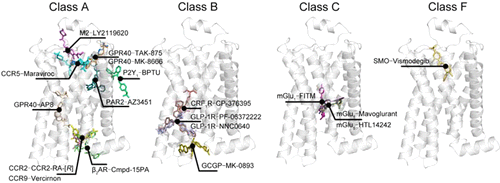当前位置:
X-MOL 学术
›
J. Med. Chem.
›
论文详情
Our official English website, www.x-mol.net, welcomes your
feedback! (Note: you will need to create a separate account there.)
Small Molecule Allosteric Modulators of G-Protein-Coupled Receptors: Drug–Target Interactions
Journal of Medicinal Chemistry ( IF 6.8 ) Pub Date : 2018-02-19 00:00:00 , DOI: 10.1021/acs.jmedchem.7b01844 Shaoyong Lu 1 , Jian Zhang 1
Journal of Medicinal Chemistry ( IF 6.8 ) Pub Date : 2018-02-19 00:00:00 , DOI: 10.1021/acs.jmedchem.7b01844 Shaoyong Lu 1 , Jian Zhang 1
Affiliation

|
G-protein-coupled receptors (GPCRs) are the largest class of signaling receptors that are most frequently targeted by therapeutic drugs. Allosteric modulators bound to GPCRs at allosteric sites provide the potential for differential selectivity and improved safety compared with traditional orthosteric ligands. The recent breakthroughs in GPCR structural biology have made structures of GPCRs from classes A, B, C, and F complexed with small-molecule allosteric modulators available. Knowledge of the detailed receptor–modulator interactions at the allosteric sites is useful for structure-based GPCR drug design of novel therapeutics. This Perspective comprehensively summarizes the current status of structural complexes between GPCRs and their small-molecule allosteric modulators, particularly the key receptor–modulator interactions at the allosteric sites. Then, the structural diversity of allosteric sites across four GPCR subfamilies is compared. This study is expected to contribute to the design of GPCR allosteric drugs with an improved therapeutic action.
中文翻译:

G蛋白偶联受体的小分子变构调节剂:药物-靶标相互作用。
G蛋白偶联受体(GPCR)是治疗药物最常靶向的最大一类信号受体。与传统的正构配体相比,在变构位点与GPCR结合的变构调节剂提供了差异选择性和提高安全性的潜力。GPCR结构生物学的最新突破使来自A,B,C和F类的GPCR与小分子变构调节剂复合而成。在变构位点的详细的受体-调节剂相互作用的知识对于新疗法的基于结构的GPCR药物设计很有用。该观点全面总结了GPCR及其小分子变构调节剂之间结构复合物的现状,特别是变构位点的关键受体-调节剂相互作用。然后,比较了四个GPCR亚家族的变构位点的结构多样性。预期该研究将有助于设计具有改善的治疗作用的GPCR变构药物。
更新日期:2018-02-19
中文翻译:

G蛋白偶联受体的小分子变构调节剂:药物-靶标相互作用。
G蛋白偶联受体(GPCR)是治疗药物最常靶向的最大一类信号受体。与传统的正构配体相比,在变构位点与GPCR结合的变构调节剂提供了差异选择性和提高安全性的潜力。GPCR结构生物学的最新突破使来自A,B,C和F类的GPCR与小分子变构调节剂复合而成。在变构位点的详细的受体-调节剂相互作用的知识对于新疗法的基于结构的GPCR药物设计很有用。该观点全面总结了GPCR及其小分子变构调节剂之间结构复合物的现状,特别是变构位点的关键受体-调节剂相互作用。然后,比较了四个GPCR亚家族的变构位点的结构多样性。预期该研究将有助于设计具有改善的治疗作用的GPCR变构药物。











































 京公网安备 11010802027423号
京公网安备 11010802027423号